#samoan history
Explore tagged Tumblr posts
Text
CHARITIE ROPATI // ACTIVIST
“She is an Indigenous (Yup’ik & Samoan) education and environmental activist and Indigenous Scientist and water Engineer. She is known for working on implementing an accurate and inclusive sub-curriculum of Indigenous peoples in Western pedagogy in Alaska. She has also worked on building pipe and water and sewage services for rural Alaska Native communities. She was awarded Champion for Change by the Center for Native American Youth for her work in education and she has been been featured and nationally recognized for her advocacy in Teen Vogue, The Malala Fund, The Guardian, Forbes and more. She has been recognized as 2023 WWF Conservation Leadership awardee and a 2022 "In the Know" Change maker. She also co-led and created policy in the Anchorage School District that allowed students to wear their cultural regalia when graduating high school. This policy is still in place and is the North America Regional Facilitator for the Youth Climate Justice Fund. She is also apart of the United Nations Women's Leader Initiative. And most recently was featured on the 2025 Forbes 30 Under 30 List, under Education.”

3 notes
·
View notes
Text
Here's my #8thRocksShuffle #8thRocks dance video w/song called Good Ol' Days by #BooYaaTRIBE.
(w/heavy rain sound effects/high tone version). I don't own this song but enjoy. #OldSchool #GFunk #Samoa #Samoan #AmericanSamoa #SamoanCulture #SamoanHistory 🇼🇸🇦🇸
#booyaatribe#Boo Yaa Tribe#samoan culture#american samoa#samoa#samoan#samoan history#g funk#old school
0 notes
Text

Samoan campers around a campfire. Textbook illustration.
New Zealand
1948
#vintage camping#campfire light#new zealand#illustration#vintage art#campfire#history#samoan#archives#1940s
130 notes
·
View notes
Text
POLYNESIAN METAL
Found another Polynesian metal band. Holy fucking shit 💀
vimeo
There's something about it. It's like Mongolian metal: a cultural combination that makes perfect sense in retrospect.
vimeo
#rock music#metal#heavy metal#thrash metal#power metal#music video#Maori#Maori metal#te reo māori#history#indigenous#folk costume#action#martial arts#New Zealand#Polynesian#music#Alien Weaponry#Shepherds Reign#Vimeo#Samoan#Polynesia#Aotearoa#Samoa#folk metal
32 notes
·
View notes
Text




#bloodline black history#the bloodline#the samoan dynasty#Naomi#wwe the rock#naomi wwe#ava raine#wwe ava#dwayne johnson#rocky johnson
10 notes
·
View notes
Text
Tattooing in the Far East and Oceania
Since preserving skin takes mummification, without direct effort, a dry climate, whether hot or cold, is needed to create them, so we don't have a complete history of tattooing in many cultures, or even back as far in history as we have evidence of humans. But, there are locations that have preserved skin or customs for us to learn about ancient practices.

Source courtesy Victor Mair, Culture: Unknown, Location: Tarim Basin, China, Date: 1000-600 B.C.
One of those deserts is in China, the Taklamakan Desert, which shows that tattoos were used around 1200 BCE, but during the Han Dynasty (202 BCE - 220 BCE), tattoos were used to mark criminals. These mummies were discovered in the Tarim Basin (which contains the Taklamakan Desert) from what are thought to be the ancestors of Uyghur people today, looking more Caucasian than Asian, were decorated with several motifs, such as crescent moons, suns, and other intricate designs, which may show their primary god and indicate they were a shaman. This interpretation is based on the evidence from near-by cultures. They also tattooed their face at times, which indicated pride in and the importance of the tattoos.

By anonymus - Mann und Weib.III. page 458, Public Domain, https://commons.wikimedia.org/w/index.php?curid=15174677
In Japan, men started wearing elaborate tattoos in the late 3rd century CE, though there is also evidence for tattooing going back to the Joumon (or paleolithic) period given that there are figurines with cord patterns on them. In the Yayoi period (300 BCE - 300 CE) tattoo designs on Chinese visitors in Kyushu were documented on, with speculation about them being spiritual or for status. In the 8th century CE "Records of Ancient Matters", tattooed people were considered outsiders, denying a history of tattooing in Japan. The Ainu people, the indigenous group of northern Japan, however, have a tradition of tattooing for decoration or status, or as protection against disease.

Te Ara The movement of peoples around the Pacific and from Asia into the Pacific over the last 6,000 years.
The Polynesian cultures of Oceania have a very long history of tattooing, developing over thousands of years and through the cultures that developed on the various islands they inhabited. The word 'tattoo' comes from the Tahitian islander's term 'tatatau' or 'tattau', as reported by James Cook's expedition in 1769.


By Louis John Steele - bwEy48meVL_AzQ at Google Cultural Institute maximum zoom level, Public Domain, https://commons.wikimedia.org/w/index.php?curid=21871113 and By Louis John Steele - bwEy48meVL_AzQ at Google Cultural Institute maximum zoom level, Public Domain, https://commons.wikimedia.org/w/index.php?curid=21871113
One of the most well known Polynesian cultures is the Māori of what is now New Zealand. Their tattoos, called 'tā moko' (the art of tattooing), are marks of high status and survived European attempts to eliminate them. Each moko is designed specifically for the person since it conveys much about who that person in, from their family to their accomplishments. On women, these tattoos are centered around the mouth and chin, while men often have tattoos around their whole faces and bodies. To receive a moku, generally certain milestones or accomplishments need to be reached and the recipient needs to have the right social status.


By Thomas Andrew (1855 - 1939) - National Library of New Zealand, Public Domain, https://commons.wikimedia.org/w/index.php?curid=10113865 and By RunningToddler - Bits & Bytes, CC BY-SA 2.0, https://commons.wikimedia.org/w/index.php?curid=3148860
Another well-known Polynesian culture with a rich tattoo history are the Samoa. In Samoa, men receive a 'pe'a' tatto, which covers their lower back and legs, and women receive a 'malu' which covers the legs from below the buttocks to below the knee. Malu tend to be more delicate and less covering than the pe'a, and are focused around a particular motif (called the malu) which is tattooed in the popliteal fossa (back of the knee), and has suggestions of shelter and protection. Sometimes, women are tattooed on their hands and lower abdomen as well. These tattoos are a sign of cultural pride, status, such that when a man completes his tattoo, he is called a saga'imitti and respected because he underwent the painful ordeal. A man without a tattoo is called telefua or telenao, meaning 'naked', and a man who hasn't completed the tattoo process because of the pain (or not being able to pay) is called pe'a mutu, a mark of shame. The tattooists (called a tufuga ta tatau) are revered as well. Modern Samoan tattoo artists continue to practice their art in the same way as they did prior to European contact, with serrated bone combs tied to tortoise shell fragments, tied to a short wooden handle and then tapped with a mallet. The ink is made from candlenut soot and stored in coconut shell cups. A length of tapa cloth (a barkcloth) is used to wipe blood from the skin and tools.

By Thomas Andrew (1855-1939) - http://collections.tepapa.govt.nz/Search.aspx?page=8&imagesonly=true&term=Thomas+Andrew, Public Domain, https://commons.wikimedia.org/w/index.php?curid=10113825
Previous post
Resources:
The Beauty of Loulan and the Tattooed Mummies of the Tarim Basin
Pacific voyaging and discovery
Tāmoko | Māori tattoos: history, practice, and meanings
15 notes
·
View notes
Note
Hello! You've been super nice with my content and I would like to thank you for being so kind 🥺
I have a question since I'm interested to ask! Can you tell me something about your culture and Samoan people? :D
Of course dearie! Everything that you've created is an ABSOLUTE stunning art! You and the others that I have followed!
And yeah! I would LOVE to! But just to let you know, I’m slowly learning as well since I was young. Because of how a slow learner I am but I will do my best to answer your question! (And it will be in a little detail for me to explain EVERYTHING about our culture.)
Starting off about the Samoan people. Us Samoan people are very strict with our culture. And they said that we're the most recognizable people showing it. Our dances, our music, visual arts. All of that! The Visual Arts are the most interesting thing that I've seen so far. Like the Tatau (tah-tah-oo).
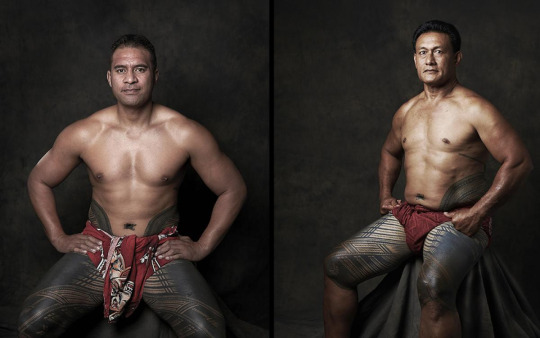
The Tatau are like tattoos mainly on the thighs and waist. You can say that they're wearing like clothing. Which means they are practically...Ahem. You should know. And they said we started using this as an inspiration by the two Fijian women who came up to the shore and brought their materials and knowledge of tattooing. Next one that we're known for Visual Arts is Siapo (see-ah-poh). A Samoan word for "A fine cloth made from the bark of the Paper Mulberry tree."
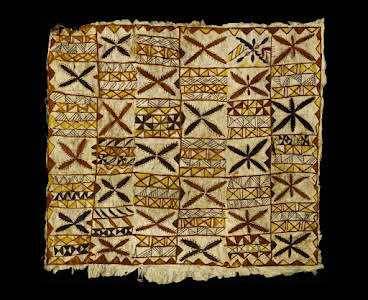
The Siapo is very important for ceremony, especially the wedding occasion and the funeral service, just to wrap the dead body and put in the grave. (Since we have caskets now. We put the Siapo on TOP of the casket instead.) It's even for High Chiefs or village maiden wearing the Siapo around their waist. Like in this old photo!

(IF you can even SEE it) Now the next one is the Ie Lavalava (ee-eh lah-vah-lah-vah). An Ie Lavalava is a piece of fabric that Polynesians tie around their waists that gets worn like a skirt. Both men and women wear this type of garment in Samoa and is considered to be a traditional daily outfit used for school uniforms or work attire paired with a jacket and tie. Like this one:
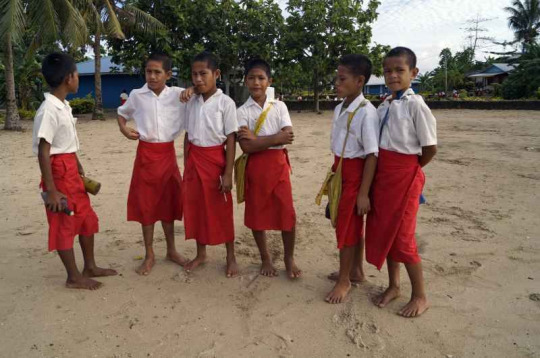
(Students wearing their Ie Lavalava for school) Or this one:

(This is somewhere in the state as they allowed them to wear it in school campus. I forgot the name of the school and place.) Men and Women wear them like that. For anywhere they go. Back in the days, my dad use to tell me that women should wear an Ie whenever they go out in the village. If they don't, it goes to show that they are not respecting our people or the village for it. And nowadays, we hardly done that. I mean, there are still some of them wears an Ie when they go out but most of us aren't. I only wear an Ie when I go to another Pastor's house or go to Church. Anyway, here is some BEAUTIFUL design that they made an Ie Lavalava!
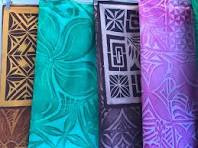

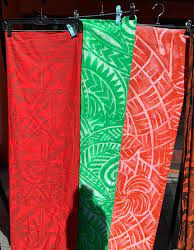
And LASTLY of the Visual Art, is Weaving. I'm sure you already know of what weaving is. For us, we weave baskets and Ie Tonga (ee-eh toh-ngh-ah). It's like the Ie Lavalava but it is made of native pandanus (lauie) tree. And it's BIGGER. I forgot if my dad told me if it was the BARK or the LEAVES they use to make it. Here is what the Ie Tonga look like:
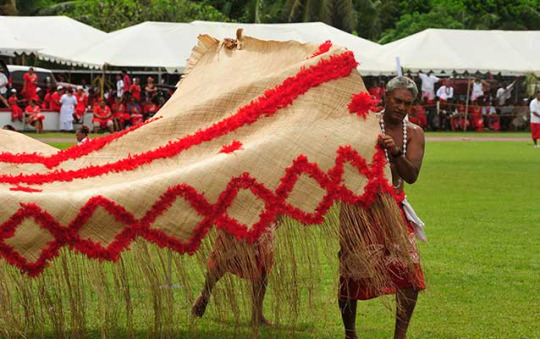
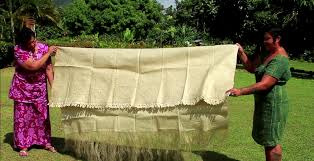
Just like that! They use these for the funerals as a gift to show their respects. I've seen this MANY times. They use these for Fa'alavelave (fah-ah-lah-veh-lah-veh). Means "Families dig deep to help fund funeral, wedding, or other life-interrupting costs, to the tune of thousands of dollars." And oh yeah, the Samoan funerals also involves money. To help out to get the things for the high chiefs and other pastors and wives. ANYWAY, they said the I'e Toga originated from our neighboring country, Tonga. The I'e Toga was originally brought to Samoa by a Tongan lady named Fuka (foo-kah). Fuka's older sister, Lautiovogia (lah-oo-tee-oh-voh-nee-ah) the Queen of Samoa, was married to the King Tuiatua (too-ee-ah-too-ah). During Fuka's visit to Samoa, she gave her sister an I'e Toga as a gift. And that's how the Ie Tonga came into Samoa. That's about it for the Visual Art. And for the music and dances. The dancing is mostly about elegant and grace. The dances also tells the story about our ancestors and mostly about love. Just like any other countries uses their music in dancing to tell the story! Another thing about us Samoans. Samoan parents are VERY strict of disciplining their children. Like let's say....Mexican/Asian/Black mothers disciplining kind of way😅. But they're just doing that out of love. Nothing abusive. I promise. And also, there are TWO different Samoa island. One island is named ACTUALLY Samoa and there's AMERICAN Samoa (That's where I'm at right now!). The differences is. Samoa are like the independent one. Nothing owns them. Until New Zealand took Samoa under them. While American Samoa is under the US. If I remember correctly the reason why American Samoa is under the US. Is because of the Americans assisting us from the war that is going on. Going against Germany, I think. So I guessed that's how we became under the protection of the US.
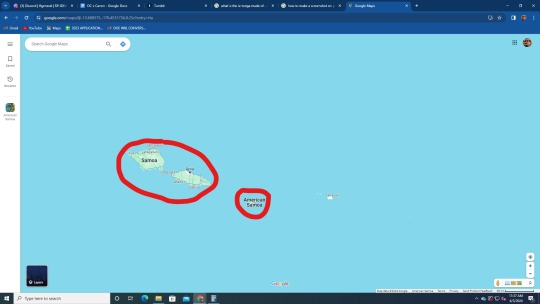
Here are the two Samoan islands. Almost close but it's like 1h 12m on an airplane and 16h on a car ferry. I prefer the plane (If I didn't pack anything HEAVY. Lol.) So yeah, that's about it. Thank you @welldonekhushi for the ask and hopefully this will help you answer your question! I'm trying be detailed as I can.
#culture#samoan culture#learning the culture#answering asks#samoan people#samoan ancestors#history#history lesson
21 notes
·
View notes
Text
#lgbtqia#lgbtq+#queer#trans women#non binary#nonbinary#lgbtq community#history#trans#samoa#samoan#polynesian#fa'afafine#fa'afatama#trans man#indigenous
1 note
·
View note
Text






#a good day spent at the powerhouse museim#I didn’t google what was on before we went so it was a nice surprise to see a queer history exhibition#there was a whole section devoted to Samoan transgender people and their cultural history#my face#but really just a midweek excursion with a friend
1 note
·
View note
Text
This is a gift article
In the final week of this election season, the Republican Party is running two different campaigns. One of them is an ugly and angry but conventional political enterprise. Donald Trump and other Republicans make speeches; party operatives seek to get out the vote; money is spent in swing states; television and radio advertisements proliferate. The people running that campaign are focused on winning the election.
Last night, in New York City’s Madison Square Garden, we caught a glimpse of the other campaign. This is the campaign that is psychologically preparing Americans for an assault on the electoral system, a second January 6, if Trump doesn’t win—or else an assault on the political system and the rule of law if he does. Listen carefully to the words of Tucker Carlson, the pundit fired from Fox News partly for his role in lying about the 2020 election. Warming up the crowd for Trump, he mocked the very idea that Kamala Harris could win: “It’s going to be pretty hard to look at us and say, ‘You know what? Kamala Harris, she got 85 million votes because she’s so impressive as the first Samoan Malaysian, low-I.Q., former California prosecutor ever to be elected president.”
“Samoan Malaysian” was Carlson’s way of mocking Harris’s mixed-race background, and “low-IQ” is self-explanatory—but “85 million” is a number of votes she could in fact win. And how, Carlson suggested, could there be such a “groundswell of popular support” for a person he demeaned as a mongrel, an incompetent, an idiot? The answer was clear: There can’t be, and if anyone says it happened, then we will contest it.
All of this is part of the game: the Trump campaign’s loud confidence, despite dead-even polls; its decision, in the final days, to take the candidate outside the swing states to New York, New Mexico, and Virginia, because we’ve got this in the bag (and not, say, because filling arenas in Pennsylvania is getting harder); the hyping of Republican-early-voter numbers, even though no evidence indicates that these are new voters, just people who are no longer being discouraged from voting early. Also the multiple attempts, across the country, to remove large numbers of people from the rolls; the many claims, with no justification, that “illegal immigrants” are voting or even, as Trump implied during the September debate, that illegal immigrants are being deliberately imported into the country in order to vote; Vance’s declaration that he will accept the election results as long as “only legal American citizens” vote.
At Madison Square Garden, Trump doubled down on that rhetoric. He repeated past claims about the “invasion” of immigrants; about “Venezuelan gangs” occupying American cities, even Times Square; and he offered an instant solution: “On day one, I will launch the largest deportation program in American history to get these criminals out. I will rescue every city and town that has been invaded and conquered, and we will put these vicious and bloodthirsty criminals in jail.” But he left open the question of who exactly all these “criminals” might be, because he seemed to be talking about not just immigrants but also his political opponents, “the enemy within.” The United States, he said, “is now an occupied country, but it will soon be an occupied country no longer … November 5, 2024, nine days from now, will be Liberation Day in America.”
The insults we heard from many speakers at Madison Square Garden, including the description of Puerto Rico as “garbage” or of Harris as “the anti-Christ” or of Hillary Clinton as a “sick son of a bitch”—insults that can also be heard in a thousand podcast episodes featuring Carlson, Elon Musk, J. D. Vance, and their ilk—are part of the same effort. Trump’s electorate is being primed to equate his political opposition with infection, pollution, and demonic power, and to accept violence and chaos as a legitimate, necessary response to these primal, lethal threats.
As I wrote earlier this month, this kind of language, imported from the 1930s, has never before been part of mainstream American presidential politics, because no other political candidate in modern history has used an election to undermine the legal basis of the American political system. But if we are an occupied country, then Joe Biden is not the legitimately elected president of the United States. If we are an occupied country, then the American government is not a set of institutions established over centuries by Congress, but rather a sinister cabal that must be dismantled at any price. If we are an occupied country, then of course the Trump administration can break the law, commit acts of violence, or even trash the Constitution in order to “liberate” Americans, either after Trump has lost the election or after he has won it.
This kind of language is not being used accidentally or incidentally. It is not a joke, even when used by professional comedians. These insults are central to Trump’s message, which is why they were featured at a venue he reveres. They are also classic authoritarian tactics that have worked before, not only in the 1930s but also in places such as modern Venezuela and modern Russia, countries where the public was also prepared over many years to accept lawlessness and violence from the state. The same tactics are working in the United States right now. Election workers, whose job is to carry out the will of the voters, are already the subject of violent threats and harassment. At least two ballot boxes have been attacked.
The natural human instinct is to dismiss, ignore, or downplay these kinds of threats. But that’s the point: You are meant to accept this language and behavior, to consider this kind of rhetoric “baked in” to any Trump campaign. You are supposed to just get used to the idea that Trump wishes he had “Hitler’s generals” or that he uses the Stalinist phrase “enemies of the people” to describe his opponents. Because once you think that’s normal, then you’ll accept the next step. Even when that next step is an assault on democracy and the rule of law.
454 notes
·
View notes
Text
Baby Daddy - J.U

A/N: just in favour of our very own main event jey uso winning the royal rumble!!! well deservedly! haters can suck his dick!!
warnings: smut & fluff (hope y’all enjoy!)
Another weekly exchange took place at your home per usual. Every Tuesday Josh would come and pick up your son Elijah until Wednesday evening. Due to his hectic road life, he really only got a day a week to spend time with his son. Josh took every single moment he got with his son, and savoured it. The problems you two had could never come in to say that Josh wasn’t an amazing dad.
Your son Elijah, was the best thing that ever happened to the both of you. You and Josh were high school sweethearts. You never once thought you would get pregnant with his child..at least not anytime soon. But in your last year of college, with a simple week of morning sickness, emotional breakdowns, and crazy cravings, you found out you would now be eating for two. And from there on out it was history.
Josh was ecstatic he was gonna be a father. From a young age he’s always dreamed of being an amazing father. He was even more happier when he found out the two of you would be expecting a boy. He was already picturing throwing around a football with his son, and teaching him all about his samoan family lineage. And even you were ecstatic.
You delivered a healthy baby boy, whom was loved by all the family around him. However for you and Josh, your relationship only weakened from that moment on. Josh was in desperate need of a job, and because of his family background, he turned to wrestling. As much as wrestling was looked at as a glamorous job, it wasn’t all that it seemed. Josh was constantly on the road, and even when he was home, he would be on interview calls or hitting the gym. You on the other hand, were just as busy as Josh. The two of you were constantly on the go and never has time for each other. So you both decided it’d be better if you broke up.
Well, it was you who broke up with Josh. It took a lot of guts to do so, but it had to be done. It was for the better…it seemed. Josh could never take the words ‘broke up’ to his heart, so he used ‘on a break’. You thought it was a immature and delusional way to deny reality, but he wouldn’t budge.
“Dada!” Elijah squealed as Josh walked through the door of your home. “Hey buddy! My mini uce!” Josh spoke back with just as much excitement. Your 2 year old son, ran on wobbly legs towards his daddy. You smiled at the sight. Josh handled Elijah on one hip, while turning to you.
“What’s up Y/n..” he spoke while Elijah was grabbing at his face. “Hey Josh, how are you?” you spoke back nervously avoiding eye contact. The truth was you’d never gotten over Josh. The road broke you two apart, also breaking your heart at the same time. You love Josh with your whole heart to this moment. He was your first kiss, your first boyfriend, your first time, and now the father of your child. When you broke up with him, you only broke your own heart too.
Now 2 years later after breaking up with him, you still want him more then ever. “I’m doing alright. Busy ya know. Well ima take Eli…i’ll see you tomorrow when I drop him off..” he told you while turning towards your door but not before grabbing Eli’s bags. “No! Mama! Come with us!” Elijah screamed out while kicking his feet all over the place.
Josh let Elijah down on the floor and he wobbled over to you. “Mama! Come with us to dada house! All of us!” he spoke on the verge of tears. “Baby..it’s dada’s time with you, i’ll see you tomorrow..” you spoke softly while caressing his little chubby cheek. “Please mama!” he cried out. He had never acted this way before.
“Baby..” you started speaking before getting cut off. “Y/n, I don’t mind if you come with us, you know it’s been a while” Josh cut you off. “Yay! See mama come with us!” Elijah then squealed. You thought about being with Josh for a long period of time, and it made you nervous yet excited. But for your baby, you would go.
“Okay, you guys wait in the car i’ll be there in a minute” you spoke softly. After grabbing your bag and some stuff you would need, you made your way out of your home locking the door behind you. You made your way into Joshua’s car, sitting in the passenger seat.
The car ride to Josh’s house was about a hour away, including the busy traffic. Josh blasted music the whole way to his house, to avoid the awkward silence. Elijah was dosing off in the back, and you took small glances at Josh when you got the chance. You felt him staring too, which only added tension.
Without either of you speaking a word to each other the whole ride, you made you way inside Josh’s beautiful beach side mansion. “Wow Josh! This place is beautiful!” you spoke astonished. He smiled at you. “Thanks...coulda been yours too..” he mumbled the last part thinking you didn’t hear. You did hear, loud and clear, which only added to your regret of breaking up with Josh. You knew he missed you, and you knew he still wanted you. You just couldn’t bring yourself to admit the fact you were still in love with him.
The evening was spent with you, Josh, and Elijah playing board games together, sitting together eating dinner, and ended with watching ‘The Lion King’ all together on Josh’s massive L shaped couch.
“He’s asleep” Josh spoke quietly. You looked down to your side to see Elijah fast asleep. “Yeah he is” you agreed. “Lemme go put him in bed, wait here.”
You waited for Josh, wanting to know why he wanted you to wait. You should be back home right now. ‘Aight..” Josh mumbled walking back into the living room, making his presence known.
He sat beside me on the couch and waited a minute before talking. “Y/n..ion even know where to start, there’s so much I have to admit to you..lemme start off by saying, I miss you, a lot.” he admitted.
You softly smiled. You were happy Josh admitted this so now you could get everything off your chest. “Josh, you don’t even know how much I regret breaking up with you back then..we were just in such a bad place and I was so scared that you’d find someone else while you were on the road, and truth is i’ve never stopped loving you..” you admitted.
He smiled at you showing off his pearly whites. “I love you too baby” he leaned in and your lips met for a soft kiss. You felt him grab your hips and pull you on top of his lap. While sensually kissing he moved your hips on top of his in a circular motion, creating friction. You gasped in pleasure softly.
You could feel a tent beginning to grow under you, adding to your pleasure. Josh groaned out. You took charge and pulled back from the kiss. “Life your arms up” you mumbled out of breath. Josh complied, and you took his shirt off.
“You sure?” Josh asked. You needed this desperately. After you broke up with Josh, you had no time to be with anyone sexually, and you missing him didn’t help the matter. “Yes, im positive” you spoke back.
You felt Josh’s hands roaming your clothed body, and he began stripping you piece by piece. Your body shivered at the sudden contact with the cold air. You were now left in only your panties, as Josh was left in his boxers. He once again moved his head down towards mines and shared a passion full kiss. Our tongues fought for dominance in which he won.
He broke away from your lips and peppered kisses on your jaw, then moving to your neck. You were surprised when you felt him sucking extra hard on your sweet spot, even after these few years, he remembered where you were extra sensitive.
“J-josh please!” you squeaked out. He continued his assault on your neck, and you swore you could feel his lips curve into a smile. “What you want mama?” he mumbled. “You..”
He pulled back from your neck and peppered kisses down towards your chest. He grabbed one of your breasts and massaged it in his large hand.
He then lowered his head down and softly took your nipple into his mouth, sucking on it lightly. You let out a moan to the feeling of his mouth. He did the same with your other breast and peppered kisses down your stomach.
He continued his kisses down to your thighs, once in a while biting down softly causing you to squeal. He was purposely denying the spot your body craved him most. Josh always knew how to drive you insane before finally giving into what you wanted.
He slowly slid your panties off in one swift motion exposing your core to the cold air. Your body was now covered in goosebumps hence the chilliness of the room.
“Missed this pretty pussy..” he mumbled while running his finger through your folds. “Yeah, yeah whatever just-” you were cut off by his head suddenly being pushed between your thighs and his mouth hungrily devouring you. You moaned out in ecstasy. You had almost forgot how talented Josh’s mouth was matched with your lower set of lips.
He sucked hastily at your clit almost sending you over the edge. You began grinding your hips onto his face, causing him to pull away quickly. “Baby if you gon cum its gon be on this dick” he spoke with deep chuckle. You whined at sudden loss of warmth from your lower region.
Josh chuckled at your neediness. As he took off his boxers revealing his hard length. You felt so touch deprived, as you moaned out into the chilly air of the room evoking a deep chuckle from him. “I gotchu baby, I gotchu..”
The tip of his dick slowly stretched you out as you almost practically screamed at the amazing sensation. Josh continued entering inside you at a steady pace allowing you to adjust to the now unfamiliar feeling. Your eyes were droopy as you looked up to see him with his mouth open as his eyes were also fluttering shut. “Damn baby, you always so tight for me, just for daddy..” he barely choked out.
Once he was fully inside you, he began thrusting into you at a very slow pace, prolonging the beautiful orgasm he knew you were on the verge of having. “P- please, daddy..please faster” you asked quietly barely being able to speak.
Without warning Josh began moving at a speed you could barely keep up with, causing you both to moan loudly with pleasure. “We gotta keep it down baby..we don’t want Eli wakin up” he spoke while not once slowing his pace.
The familiar feeling began brewing inside your lower belly, tingling all around signalling you were close. “I’m almost- i’m gonna” you choked out on the verge of tears. You forgot how intense sex was with Josh.
“I know baby, I know..” he mumbled while moving his hand down to playing with your clit sending you straight over the edge. “Fuck Josh!” you wailed as he held you down with his arm as you convulsed.
He continued chasing his own nut at a severe pace, which was slightly overestimating you. Before you could get a word out you felt his warm speed paint the walls of your now swole pussy.
He moved off you, lying down on the couch beside you gathering you in his arms before pressing a soft kiss to your temple. “I love you baby, and I want us to be a family this time, for real.”
“Mmm yeah me too, love you Josh..” you whispered as sleep overcame your body, while you slept in the arms of the man you have always and always will love.
#roman reigns#wwe#jey uso#jimmy uso#wwe smackdown#the tribal chief#head of the table#wwe raw#but look at jey in the 2nd gif. why's he tryin ta look at em like that. 🤣 jimmy just be chillin' in the back. what a bunch of goofs.#main event jey uso#jey uso smut#jey uso x reader#jey uso fanfiction#jey uso wwe#jey uso fluff#jey uso fanfic#roman reigns fanfiction#wwe roman reigns#roman reigns one shot#uceyjuiicey#big daddy uce#baby daddy#smut#fluff#roman reigns imagine#roman reigns wwe#wwe jey uso
269 notes
·
View notes
Text
TERISA SIAGATONU // POET
“She is a Samoan spoken word poet, arts educator, and community organizer. In 2012, she was awarded a Champion of Change Award for her activism in LGBTQ rights, racial justice, mental health, gender equity and climate change. Siagatonu is a queer Samoan woman and activist. She spoke at the Obama White House and to the UN Conference on Climate Change in Paris, France.”


0 notes
Text
Here's my #8thRocksShuffle #8thRocks dance video w/song called Good Ol' Days by #BooYaaTRIBE(w/heavy rain sound effects/high tone version) on YouTube. Also click the like, share, subscribe, & hit a notification button on my YouTube channel. #OldSchool #GFunk #Samoa #Samoan #AmericanSamoa #SamoanCulture #SamoanHistory 🇼🇸🇦🇸

#Boo Yaa Tribe#BooYaaTribe#Samoa#Samoan#Samoan History#american samoa#g funk#old school#samoan culture
0 notes
Text
Paul Heyman just looked CM Punk in the eyes and basically said:
“I will risk death by Samoan Spike to stand by you at WrestleMania.”
LIKE HELLO??? THIS ISN’T MANAGER ENERGY, THIS IS SHAKESPEAREAN TRAGEDY HEROISM.
He’s out here:
-Betraying Roman
-Putting himself directly in the fire
-Fully prepared to catch hands, spears, and possibly a steel chair to the spine
ALL FOR CM PUNK.
The way his loyalty fluctuates for drama but always feels so personal and emotional??? I’m unwell.
Protect that man. Wrap him in bubble wrap. Give him an Oscar. If he gets hit at Mania, I will riot, sob, and create a 7-part Tumblr slideshow titled
“The Tragedy of Paul E. Dangerously.”
PAUL HEYMAN IS THE MOST DRAMATIC, LOYAL, STRESSED-OUT LITTLE FRIEND IN WRESTLING HISTORY AND I LOVE HIM WITH MY WHOLE HEART.
Like this man built an entire career out of:
-Screaming ringside like a wet cat
-Manipulating empires
-And being emotionally torn between his children like a divorcé in a custody battle
But when it counts?? He shows up. He’s there.
CM Punk said, “I need you,” and Paul was like
“Say less, I’ll bring the bloodline drama and my legal will.”
The way he looked when he agreed?? You could see it in his eyes:
“I know this will ruin everything… but I love you, Bestie.”
If anything happens to him at Mania I’m throwing myself onto the stage like
“LEAVE HIM ALONE, HE’S JUST A LITTLE GUY!!”
We don’t deserve him, but we are BLESSED by his presence.
48 notes
·
View notes
Text
Her Majesty The Queen’s speech to the CHOGM Women’s Forum, 24.10.2024
Prime Minister, Ladies and Gentlemen, it is a huge pleasure to be here with you today. I would, first, like to thank the people of Samoa for the warm welcome that my husband and I have received and for your hospitality and generosity to us and to the whole Commonwealth family.
I was delighted recently to come across the wonderful Samoan proverb: E au le Inailau a Tama’ita’i. With apologies to the men in the room, I thought that we might make this our motto today.
According to a legend, a competition was once held between men and women in a village to thatch the roof of the house of Chief Tautunu. Although they started at the same time, the women finished their side first, as they had laboured through the night, while the men slept. As one whose husband is often toiling into the small hours, long after my head is on the pillow, I should stress there are plenty of exceptions! But the moral of the proverb is: Women will turn their hands successfully to any task that must be done; and will work hard until it is completed.
As we gather to discuss our theme, “Advocating for Women and Girls in the Commonwealth”, we have a gigantic task ahead of us, for which we all – male and female – will need the same spirit that inspired those women thatchers. It is this: to end domestic and sexual violence across the Commonwealth, now and forever. And its enormity can be seen from the shocking statistics. Globally, 30% of women have been subjected to either physical or sexual violence in their lifetime. Most of this at the hands of an intimate partner. Worldwide, 27% of women aged 15-49 who have been in a relationship, report that they have experienced some sort of abuse from their partners.
Faced with the vastness of the issue, it can seem almost impossible to know where to begin. Yet our Commonwealth’s 75-year history offers hope, inspiration and – crucially – solutions. Leaders from around the globe are willing to meet, as equals, and to have difficult, and constructive, conversations.
The Commonwealth Says NO MORE campaign, which takes a culturally sensitive approach towards ending domestic and sexual violence, is supporting people from all walks of life to identify and implement practical steps which we can all take to make homes, workplaces and communities safe for women and girls. We know that abuse can be prevented and ultimately eliminated, but only if we work together until that task is completed.
That is our commitment – to each other, to the Commonwealth and to the generations to come.
E au le Inailau a Tama’ita’i.
Thank you.
36 notes
·
View notes
Text
Top 10 Pacific Islands Materials in Our Collection
While Pacific Island cultural experiences are far and few in Iowa, Special Collections & Archives is the proud host of a number of rare and highly regarded publications by prolific Pacific Islander creators or about the rich histories and cultures of the islands!
Te Kuia me te Pungawerewere (The Kuia and the Spider) by Patricia Grace.


(X-Collection Folio PZ5.G73 K85 1981, X-Collection FOLIO PZ5.G73 K853 1981)
Patricia Grace’s Māori children’s book, Te Kuia me te Pungawerewere, it’s English language version titled The Kuia and the Spider, is the tale of a Kuia, meaning elderly woman or grandmother in English, and a spider who share a kitchen and are in a constant playful argument of who is better than the other. Patricia Grace, a former school librarian herself, is a famed Māori writer of novels, short stories, and children’s books. The publication of this book in both English and te reo Māori, the Māori language in the 1980s was of great importance to language revitalization efforts following the presentation of the Māori Language Petition in 1972 and the officialization of Māori Language Week in 1975. Te Kuia me te Pungawerewere was awarded New Zealand Picture Book of the year in 1982 and remains a beloved story by Māori educators and families.
Tongan Ngatu.


(MsC 913)
Ngatu, or ngatu hingoa, in the Tongan language refers to the elaborately decorated tapa bark cloth tapestries of Tongan cultural significance. The art of ngatu is made distinct through processes of dying, stamping, and hand painting the tapestries, though still similar to the artful practices using tapa bark cloth in other Polynesian islands. The ngatu held in Special Collections was likely created in the 1940s, during or after World War II, and includes illustrations of planes to commemorate the contribution of the Tongan Defense Force to the British war effort. The tapa, or bark cloth itself, is likely made from mulberry tree bark, commonly used in the Pacific for this exact craft. Illustrations and stamping was likely done with dyes made from saps of other native Tongan plant species, such as candlenut trees.
Roma Potiki by Roma Potiki.
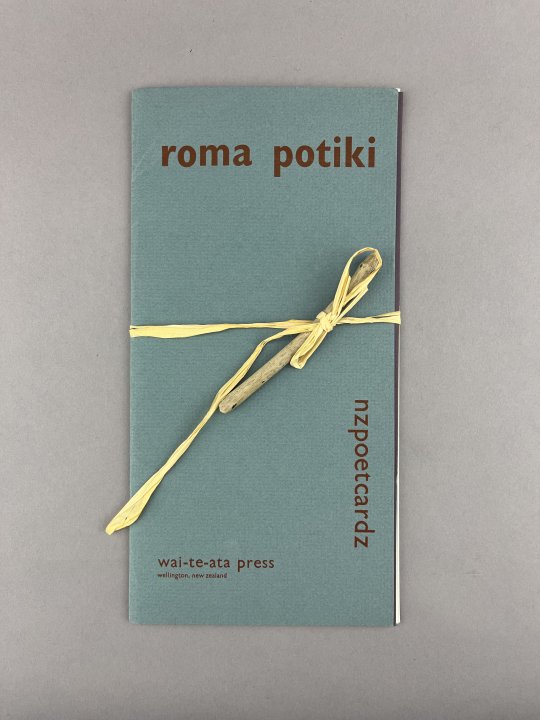

(X-Collection Folio PR9639.3.P59 R6 1996)
Roma Potiki is a noteworthy contemporary Māori poet, playwright and performer. Her self titled collection of poetry explores themes and topics of nature, the human spirit, Māori womanhood, politicization, and the lasting effects of colonization. The poems in this limited collection were also published in her 1998 collection, Shaking the Tree.
Death and the Tagua by Alistair Te Ariki Campbell.


(X-Collection Folio PR9639.3.C275 D4 1995)
Alistair Te Ariki Campbell is famed New Zealand poet and playwright of Cook Islands Māori descent. This collection of poems, Death and the Tagua, is the artistic account of and response to Campbell’s own journey from Rarotonga in the Cook Islands to New Zealand via a Tagua sailing vessel, and the deaths of both of his parents in his early life. More information about the Death and the Tagua can be found in our YouTube series, Nibbles of Knowledge.
Tapa: the bark paper of Samoa and Tonga by Lilian Bell & Ulista Brooks.



(Smith Miniatures Collection TS1095.S36 B45 1979)
Tapa is the bark paper or cloth of Polynesian islands including Samoa and Tonga, as specifically shown in this miniature book of paper samples. The bark of mulberry trees among other plants is processed into a fibrous paper, that is often then ornately decorated with dyes for cultural customary or celebratory purposes. In Tongan culture, these decorated tapa are called ngatu, and in Samoan culture, called siapo.
Whanau by Witi Ihimaera .


(X-Collection PZ5.I35 W43 1974)
Whanau, meaning family in te reo Māori, is a story of just one day in the lives of a large family living in a rural Māori village, struggling with the loss of traditional values and ways of living due to colonial pressures. It is the second work published by Witi Ihimaera, who is considered one of if not the most influential Māori writer still today. He was the first Māori writer to ever publish both a novel and book of short stories. The story takes place in the small town of Waituhi, were Ihimaera himself was raised and inspired to become a writer after seeing the erasure or mischaracterization of Māori in literature in New Zealand and globally. Our copy is signed by Ihimaera, with a note to the book’s donor, Carmon Slater, that reads “To remind you of a wonderful partnership and warm time at Tokomaru Bay when we worked on improving the self image of Māori Children.”
Ethnic Foods of Hawai’i by Ann Kondo Corum



(Szathmary Collection TX724.5 .H3 C68 1983)
Ann Kondo Corum, formerly a school librarian in Honolulu, wrote and illustrated Ethnic Foods in Hawai’i to provide a sense of history and culture through the foods and cooking traditions of the now multi-racial state of Hawai’i. She saw a need for this during her time as a librarian, when students had trouble finding information about the foods and culinary customs of their peers. This cookbook dives into the history and popular traditional recipes of the major cultural groups on Hawai’i, including traditional Hawaiian and Samoan recipes, celebrations, and culinary customs.
Māori Legends illustrated by Manu Smith.


(Smith Miniatures Collection GR375 .M36 1993)
This miniature book is the illustrated telling of major Māori legends or oral histories, including those of Maui, Pania, and Rona, the woman who went up to the moon. Illustrations are done by Manu Smith, who is also known for having illustrated Māori legends series for New Zealand stamps and phone cards in the 1980s and early 2000s.
Standing Place by Fred Hagstrom.



(X-Collection Oblong N7433.4.H25 S73 2012)
Fred Hagstrom is an artist and Professor Emeritus of Art and Art History at Carleton College in Minnesota. Standing Place is an artistic telling of a story about shared culture and the soldiers of the Māori Battalion during World War II. This covers the story of Ned and Katina Nathan, who are also the focus of Patricia Grace’s book, Ned and Katina. In his artist statement on the piece, Hagstrom writes: "I take students to New Zealand every two years, and in doing that have made good friends at a Maori Marae, which is a tribal meetinghouse. This is the story of their parents. … They also founded the Marae that I visit. This book is made in the friendship I feel for this remarkable family." The Marae in mention is the Matatina Marae at Waipoua. The kawai pattern on the book’s cover, titled Tatai Hono (the joining of lines of descent) was designed by Manos Nathan, son of Ned and Katina.
Francis Wherahiko Rawei, from the Redpath Chautauqua Bureau Records



(MsC0150 Box 238, Box 272)
Francis Rawei, also known by his former name Wherahiko Rawei or his stage name Dr. Rawei, was a Māori performer and educator of the early 20th century. Alongside his wife Hine Taimoa, a lecturer, harpist and singer herself, he toured internationally lecturing, singing and story-telling about Māori history, life and culture. Together they toured the United States and Canada on the Chautauqua circuit and lived briefly in Chicago before eventually returning to New Zealand.
Also worth mention are the many travel diaries and publications collated by some of the first foreign seamen to arrive in the South Pacific. I have very intentionally not included any of these materials, as these diaries are predominantly accounts of travel to these islands with the goal of imperial conquest or religious purification of Indigenous Pacific Islanders, and unfortunately are not without deeply racist and offensive language. This undoubtedly makes these materials challenging to read and engage with, but the effects of colonialism and religious missionary efforts are very real and prominent parts of Pacific Islands history, as well as our present day. Their place in a rare book repository is just as important to the preservation of Pacific Islands history and culture as those included on this list.
--M Clark
#special collections#uiowa#miniature books#rare books#uiowaspecialcollections#libraries#maori#pasifika
23 notes
·
View notes